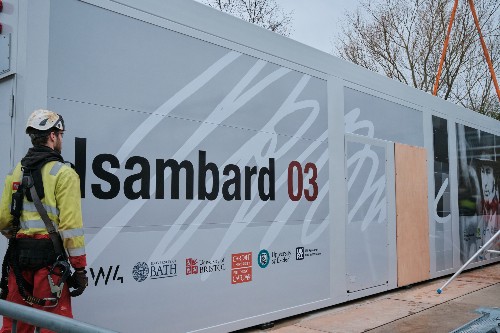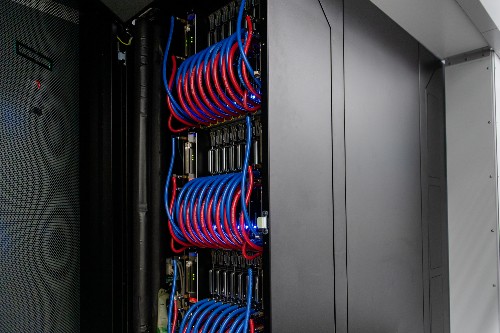
Isambard 3 Modular Data Centre where phase one of Isambard-AI is temporarily housed. Christy Nunn

Isambard-AI phase one. Christy Nunn

Professor Judith Squires, Provost and Deputy Vice Chancellor (centre) with Professor Simon McIntosh-Smith (left) and Dr Jon Hunt, Executive Director, Research & Enterprise (right) with delegation from DSIT, UKRI and University of Cambridge at the National Composites Centre (NCC). Christy Nunn
The UK'S fastest and most powerful supercomputer, located at the University of Bristol, is now officially online, with pioneering technology helping to make the UK a world leader in artificial intelligence.
As it goes live, the multimillion Isambard-AI has appeared in the global power rankings for the fastest and is now officially the second most sustainable supercomputer in the world as it shoots into the top two of the Green500.
Scientists will soon be able to use the world-class equipment for research that has not been possible in the UK until now, with organisations such as the UK's AI Safety Institute expected to be amongst the first to harness its capabilities for AI research from this month.
The new Bristol Isambard-AI facility will be used by a wide range of organisations from across the UK to utilise the power of AI, which is already propelling emerging technologies such as training large language models (LLMs), healthcare and robotics. The supercomputer will also play an essential role in critical areas such as AI safety, accelerating automated drug discovery and climate research.
With the latest technologies, including HPE Slingshot 11 interconnect and direct liquid cooling solutions with highly-integrated, heterogeneous CPU-GPU systems from NVIDIA, it is one of the most efficient supercomputers that has ever been built.
Bristol's Isambard-AI phase one has also appeared at position 129 in the latest edition of the TOP500 list of high-performance computing (HPC) systems on Earth, as published at the ISC High Performance 2024 event in Hamburg, Germany.
University of Bristol's Vice-Chancellor and President Professor Evelyn Welch said: "With Isambard-AI phase one turned on, and primed for action later this month, we welcome this huge step forward towards providing UK researchers with world-class AI and HPC resources, until now accessible by few.
"This will equip the UK with the means to drive the next wave of scientific breakthroughs and positions Bristol as a vital cog in global technological discovery that will improve people's lives."
Professor Judith Squires, Provost and Deputy Vice Chancellor, who joined a Government delegation to the Isambard-AI site, said: "The speed with which this project is being delivered is testament to the expertise and ambition of our hard-working HPC and AI teams here at the University.
"The arrival of Isambard-AI phase one, builds on Bristol's reputation in AI research and training; home to two Centres for Doctoral Training in AI, as well as two new national AI research hubs, our state-of-the-art capabilities will enable us to push the boundaries of scientific research to make breakthroughs that will benefit everyone."
Professor Simon McIntosh-Smith, Director of the Bristol Centre for Supercomputing at the University of Bristol, explained: "Assuming there are eight billion people on earth, and everyone performed one calculation per second, it would take 2.3 years for all eight billion people, working 24/7, 365-days a year, to do what Isambard-AI phase one could do in one second.
"That's a pretty astounding performance, even though we can pack it into a relatively small space.
"Isambard-AI phase 1 signifies the start of the Isambard-AI service. When the remaining 5,280 GPUs arrive at the University's National Composites Centre (NCC) later in the summer, it will increase the performance by a factor of 32."
Following a £225m investment from the UK Government last autumn, with thanks to HPE modular data center technology; the Isambard-AI phase one with HPE Cray EX2500 supercomputer and168 NVIDIA GH200 Grace Hopper Superchips has been delivered in record time, signalling the speed at which AI is advancing and recognising the value of having a national AI Research Resource in place.
Minister for AI Viscount Camrose said: "With the launch of the first stage of University of Bristol's supercomputer Isambard-AI, we're witnessing a groundbreaking moment for UK science, innovation, and technology. This world-class equipment will revolutionise research possibilities here in the UK, with our world-first AI Safety Institute among the organisations who are set to benefit by harnessing one of the most powerful computer systems on the planet to drive forward their vital research.
"Not only does Isambard-AI rank among the world's fastest supercomputers, but it also sets the standard for eco-conscious computing, leading the charge in efficiency and sustainability. From AI safety to healthcare and climate research, its capabilities are unparalleled, marking the UK out as a global leader in AI and responsible innovation."
"It is exciting to see Isambard-AI entering the first stage of its journey to deliver Europe's largest AI system for open science and propel the UK as a global leader in AI," said Matt Harris, managing director for UK, Ireland, Middle East and Africa at HPE. "With AI progressing at rapid pace, we are proud to have delivered the system in a record time, with just 3 months between concept design and the system going live. This unique supercomputer is the centrepiece of the UK Government's AI Research Resource and will enable organisations like the AI Safety Institute to train generative AI models at scale with research outcomes expected as soon as May this year."






